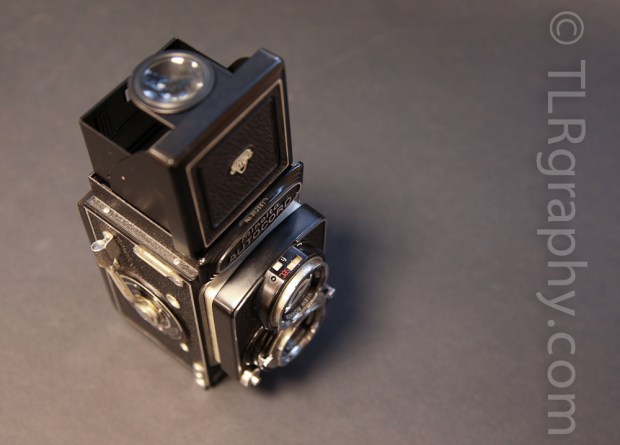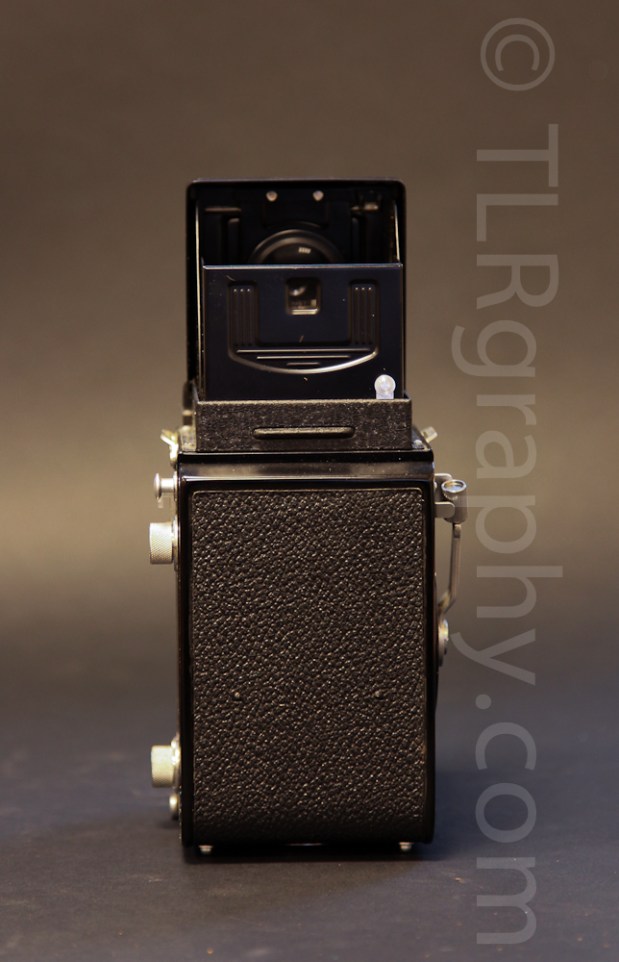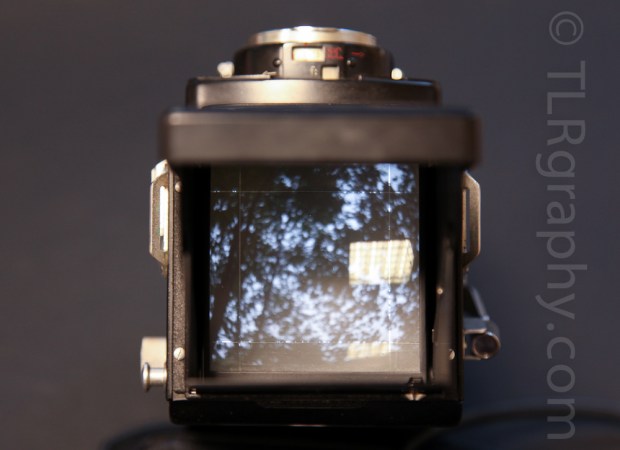Minolta Autocord RG V1, 1961, SGD 375.00
About Minolta Autocord
Twin-lens reflexes bearing the Minolta name had been offered as early as 1937, starting with the Minoltaflex (I). However, by the mid-1950s, the Japanese TLR market had become quite crowded. The Minolta Autocord series was an effort by Chiyoda Kogaku Seiko, K.K. to compete in the premium-quality segment of the TLR market.
The Autocord series went through a large number of minor variations during its lifespan between 1955 and 1966—at least 17, by one count.[1]
All shared a number of desirable features: crank film advance with automatic shutter cocking and frame counting; a highly regarded Tessar-type 4-element Rokkor f/3.5 lens; self-timer; slow shutter speeds, down to 1 second; and an override button, allowing the advance crank to rotate backwards and cock the shutter without advancing the film, permitting double exposures. Early Optiper shutters only had speeds to 1/400 sec., but this was increased to 1/500 in later versions.
These features compared well with a Tessar-equipped Rolleiflexof the day, yet Autocords sold at a subtantially lower price. Both meterless models and ones including a light meter (originally selenium; later, CdS) were offered in parallel throughout the series.
Many versions of the Autocord feature some form of EV number scale around the taking lens to assist with exposure settings. Some metered models use a quirky system where the shutter and aperture indicators each point to a different row of integers; the photographer was intended to mentally add these two numbers until they equaled the EV indicated on the light meter. A 1957 magazine ad proclaimed, “Your wife or child could have done it—even without looking at the f/stop or shutter speed numbers.”[2] Despite this appeal to the male ego, the system was never adopted by any other camera maker, and no doubt perplexes Autocord purchasers today who are missing the original manual.
Autocords use a focus lever that protrudes from below the lensboard. Some photographers have noted the ergonomic advantage of this design compared to knob-focusing TLRs such as the Rolleiflex, as it is not necessary to shift the camera between hands for focusing versus winding. But the metal of the Autocord lever is brittle and vulnerable to breakage—the one notable weak link in these otherwise excellent cameras. This focusing mechanism is also found on all postwar Flexarets, beginning in 1945, according to McKeown.
This Minolta Autocord I is a late model among the popular Autocord series of TLR (Twin Lens Reflex) medium-format cameras. It was first introduced in 1965. This meterless camera is equipped with a Citizen-MVL shutter and a Minolta Rokkor 1:3.5 f=75mm taking lens.
The photos below are my Minolta Autocord RG Version 1, Enjoy!!

thanks for viewing
let me know if you are interested in getting this camera
tlrgraphy AT gmail DOT com
Price: SGD 375.00
Approaches to replace mercury px625 battery
What is mercury px625?
The PX625 (also referred to by other names such as PX13) is a small button-shaped 1.35volt mercury battery which great number of camera models were designed to use.
Before the manufacture of mercury batteries was banned, many cameras were designed to use them. Because mercury batteries produced a constant and reliable voltage, many cameras were built without any voltage regulation in the metering circuitry. Unless preventative measures are taken, use of other kinds of batteries gives erratic exposures and meter readings.
Brands and Cameras designed to use px625 battery
| Manufacturer/Brand | Model |
|---|---|
| Agfa | Optima 500 Sensor, Selectronic, Selectronic S, Agfamatic 300/4000/4008/5008/6008, Optima 535/1035/5000/5008/6000/6008 |
| Alpa | 9d |
| Argus | 270 Insta-Load |
| Bell & Howell | FD35, Autoload 340/341, Auto Reflex Dial 35 |
| Bronica | C2, S2 |
| Canon | FT, FTb, FTbn, FT-QL, TX, TLb, EF, F1 (some), Ex, EX EE Auto, A35F, Demi 17, Demi EE 17, Canonet QL17/QL19/19E/25/19E, Canonet New QL17/New QL17L/New QL19/New 28/G-III 17/G-III 19 |
| Chinon | SLR, 1000EL pocket, CS, CXII |
| Dacora | Rapid D101, D202, D404 |
| Edixa | LTL, 35MM, Prismat, Amica Auto,TL 1000 |
| Exakta | TL1000, RTL1000, Examat & Travemat meter finders |
| Fuji/Fujica | 35FS, 35GP, V2 |
| GAF Corporation | L-14, L-17, L-CM, L-CS, Anscomatic 726, Autoset Cds |
| GAF Bernard | Auto 35, Model 503, Viceroy 5000 |
| Hanimex | 35EE, 35SL, 120, 620, Compact A |
| Hasselblad | Meter Prism Finder CdS |
| Kalimar | K650, K431 Cds meter, K433 zone meter, Zanit 2000CTL |
| Keystone | K609H, K610H, K616D, K164H, K615H, K1010 Auto |
| Kiev | 60 TTL (2 each) |
| Kodak AG | Retina IIF |
| Konica | AutoReflex T4/TC/Autorex, Auto S/S1.6/S2/S261 meter, EE-Matic, EE-Matic Deluxe F/FM, c35/c35 Flashmatic |
| Kowa | SE, SER, SET, SETR, SETR2, 6, 6 MM, Super 66 |
| Leica | CL, M5, Leicaflex SL/SL2/SL-MOT/SL2-MOT |
| Minolta | SRT 100/101/200/201/202, SR 1/7/7V/100/102/200/201/202, AL-F, AL-E, Autopack 700, Himatic 7/7s/9/11 |
| Minox | 110S |
| Miranda | Sensorex, Automex II/III, F, FM |
| Nikon | F, FTn, FT, T, Tn, Nikkormat FT/FTn/FT2 |
| Olympus | 35 series: 35DC/35LC/35RC/35RD/35SC/35SP/35SPN/35UC, EED, Pen FT, FTL, M-1, OM-1, OM-1MD, OM-1n |
| J.C. Penny | SLR2/SLR3 |
| Petri | FT, FTIII, F1X, Racer, Petriflex 7 |
| Praktica | TL, TL1000, Super TL/TL2/TL3, LTL, LTL3, MTL3, MTL5, Praktica 66 meter, Prakticamat |
| Ricoh | Simplex, Simplex II, SLX 500, TLS 400/EE |
| Rollei | 35, 35S, 35T, 35 Classic, A26, 126, XF35, Rolleiflex SL35, SL35M, SL26 |
| Spiratone | Spiraflex TTL |
| Topcon | RE Super, Super DM, 135EE |
| Vivitar | 35EE, 35EF, 35ES |
| Voigtländer | VF101, VS1 |
| Yashica | MAT 124, MAT 124G, Y12, Y24, Half 14, Lynx 14/14E/5000, Ministar 700D, Penta J3/J4/J5/J7 |
| Zeiss Ikon | Contaflex 126/SLF, Contarex Super/Super BC, Icarex 35S/35CS, SL706 |
| Zenit | Zenit TTL, Zenit 16, Zenit 18, Zenit 19, Zenit , Zenit Avtomat, Zenit AM, Zenit APK |
Approaches to replace mercury px625 battery
a. CRIS MR-9 adapter.
http://www.criscam.com/mercury_battery_adapters.php
Good: Uses Silver Oxide batteries SR-44. More available than other adapters.
Potential Bad: Expensive
b. PaulBG’s Adapter
http://www.paulbg.com/Nikon_F_meter_batteries.htm
Good: Cheaper. Uses Zinc Air batteries aka Hearing Aid battery.
Potential Bad: The battery will die every 3 months regardless of usage. It is cheap but you have to check on the battery.
c. DIY from old PX645 battery
Remove the centre piece of the PX645 battery leaving only the ring. Place a Zinc air battery in the centre and uses aluminum foil between the battery and ring.
http://www.kyphoto.com/classics/mercurybattery.html
4. these easiest way: wein cell px625
can easily get from amazon, antiquecamera.com, ebay and other online places. A genuine piece of wein cell usually costs around 6-7 US Dollars.
Yashica Mat 124 Battery Replacement
Yashica Mat 124 Cleaning (4 of 4): Battery Replacement
This is the final post in a series of four related to cleaning my used Yashica Mat 124. The first post in the series describes the task in more detail and includes links to all of the other posts.
A common complaint with used Yashica Mat 124 / 124G cameras is that that meter is inoperative. On my camera, the eBay auction stated that the meter no longer worked, but I suspect the seller never even bothered to try a new battery in it. So, it is often worth asking if they’ve tried the meter with a good battery before you determine that it no longer works.
The problem is that the 124 and 124G are designed to run off a mercury 625 cell (generating a nominal 1.4 volts) that has been banned due to mercury content. As a result, it is very hard to find 625 batteries for these cameras, and even if you can find one, can you really deal with the guilt of putting poison into the environment? The replacement 625, if you can even find one, is typically alkaline with a nominal (and unstable) voltage of 1.5 volts, which causes the 124 metering to read incorrectly (too high, I believe, causing under-exposed photos).
The best replacement (chemically) is a zinc-air battery, but zinc-air batteries are not commonly sold in the 625 size. A readily available alternative is the zinc air 675 battery, that produces the needed 1.4 Volts stably across its life cycle but does not fit in the Yashicamat 124(g) straight out of the box. The image below depicts this physical difference:
As you can see, the 625 has a much larger diameter and slightly more height. There are a variety of strategies to get the 675 zinc-air batteries into older cameras – this great page at KYPhoto describes many of the ways. Probably the easiest are Wein cells — newer zinc-air batteries with the right size specification. But, Wein cells tend to be harder to find and more expensive than similar batteries because they are a specialty commodity.
The approach I’ve taken is to adapt a 675 battery to fit the space of a 625 battery — Rick Oleson has a good page on this which is similar to my approach. The basic idea is to increase the diameter of the battery (by placing a spacer in the battery holder) and increase the height slightly since the 625 is usually held by the lip around the outside (not the positive terminal face) but the 675 does not have the lip. In the image above, you can see the battery holder on the 124 (which includes a metal screw-in top). But, where Rick Oleson uses wire, I use one of these and some aluminum foil:
Your local hardware store has a wide variety of faucet O-rings that work great for the spacer with the bonus of well-calibrated size and non-conductivity. I used a 7/16″ I.D. and 5/8″ O.D. ring and it cost me less than $1 for two of them.
Battery-wise, I spent $6 at my local Fry’s Electronics for a pack of 6 Energizer 675 zinc-air batteries:
The image that started this post shows the materials used. Just insert the o-ring into the hole in the camera (it will fit snugly), place the battery on top of the foil on the cap, and screw the cap back in. I found it best to hold the cap up with the camera battery holder upside down keep stuff from falling apart. The battery goes in snugly and securely and automatically centers itself.
And, the end result is a working match-needle meter:
Note the red needle, driven by the battery and sensor, that you need to line up with the yellowish-green ‘hook’. Easy, costs less than a buck for the parts and a buck a battery, and works pretty well!
Update: Well, I spoke a little too soon on things working well. My meter has been malfunctioning and reading low. Sometimes, when I open the hood up it does not turn on, and sometimes even when it does work it twitches all over the place. I need to look into it more, but it is likely either the battery contact (which is somewhat corroded — I originally sandpapered it, but I don’t think it took) or, more likely, the switch in the hood is flaky. I’ll open it up in the near future and see what I can do. The camera is so much easier to use when the meter is operable, even if the meter is a little imprecise!
Update #2: (10/25/09) The foil ended up being less than reliable, since it tends to compress over time and it may cover the air holes of the battery (causing inconsistent metering). Instead, I found a twisted spiral of copper wire (22 AWG) does a good job of spacing the battery without restricting airflow:
via Yashica Mat 124 Cleaning (4 of 4): Battery Replacement « Used Camera Database Blog.
















